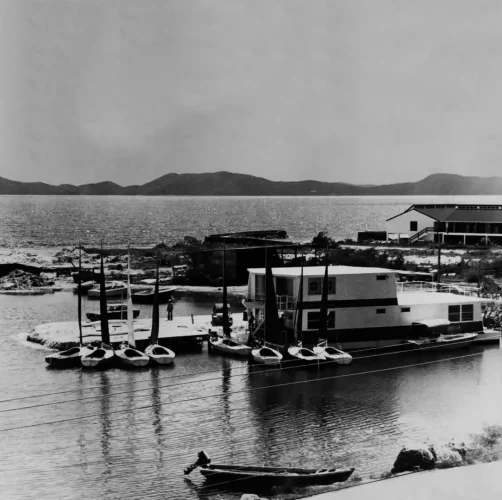The Rise of Road Town
Road Town: The British Virgin Islands capital that holds registries from more than 500,000 international business companies and a wealth of physical businesses that exist to facilitate their needs. Since the early 1980s, when double taxation exemption laws began to attract international business companies, the tiny town has grown exponentially to contain the dozens of businesses and thousands of employees that have flooded these shores. And today, during a time when the global economic climate has put a halt to many development projects, Road Town finds itself in a peculiar game of tug-of-war between supply and demand needs.

It’s hard to drive through Road Town without noticing some sort of construction in the area. Currently, the skeleton of the Cutlass Building above Simply Delicious is casting a six-storey shadow over First Bank; the new tri-level home for the Virgin Islands National Bank is in its outfitting stages a few doors down; and the Samuels Richardson & Co. law firm is having their new offices built on Main Street, across from Serendipity bookstore. Then there are a couple of developments that haven’t gotten off the ground yet, their “coming soon” signs gracing the overgrown lots next to Pusser’s and the Sol gas station by the Road Town Roundabout. There are also the recently completed six-storey office spaces at the Commerce House, which won the favour of fans in this magazine’s October 2012 “Best Of” issue, and the Ashley Ritter building at Wickhams Cay II.
Filling the void
All of these recent and soon-to-come developments share different stories of how they came to be, or how they hope to become. Developers shared mixed tales of optimism and pessimism when interviewed about their decisions to build during a time when many businesses in the territory are either consolidating their office spaces to save on spending or are closing their doors entirely. For some, like JOMA Properties CEO Colin O’Neal, success in these trying times hangs in the balance between supply and demand.
“What I’ve been noticing over the past two years is there has actually been a significant slow-down in the demand for office space, for a number of reasons,” said O’Neal, whose JOMA Properties owns more than 250,000 square feet of commercial real estate. “First and foremost, you look at the market for office space—trust companies, law firms, insurance agencies—operations have basically dried up as a number of them have consolidated; consolidation in the industry has shrunken the demand for office space.”

Continuing, he said that the majority of businesses have taken cost-cutting measures that have thwarted their need to branch out and occupy other spaces, like those vacant ones on the first through fourth floors of the Commerce House, owned and managed by JOMA.
“I think Commerce House is very illustrative of these trends,” he said of the commercial building that was conceived in 2006. “It’s basically a building that came on to the market at the worst possible time, and occupancy is far lower than we expected in a time when things looked much different; everything looked extremely good—probably the best in my generation. You could rent real estate quicker than you could build it.”
Currently, JOMA is working on a conception that would transform the Port Purcell area into a major commercial office park—but those plans have been slowed due to the cloudy economic climate, he said.
“Real estate is driven by demand, and that demand is in turn dependent on jobs in a growing economy,” he reiterated, adding that JOMA currently has an overall occupancy level between 85-90 percent within all of their commercial spaces. “And we’ve got no control of the demand side. We have plenty of things we’d like to do but presently have put them on hold until we can see some growth in the economy.”

Chicken and egg
As of press time, the two new six-storey commercial developments—Commerce House and Ashley Ritter—shared a mere 33 percent occupancy rate. For lenders, these sorts of statistics play a pivotal role in determining risk assessment factors before dishing out a loan. Sjoerd Koster, head of banking at VP Bank, recently spoke about the heightened cautionary measures that banks use when judging loan candidates. The most important factor a bank must look at, he said, is the return from a loan-to-value point of view.
“In the last two to three years, because of the shift in the real estate market worldwide and in the BVI, margins for lending have shifted significantly,” he said of the amount of money a bank would loan on a deposit. “Commercial loans have shifted from 70 to 60 percent [of a bank’s portion to a client’s down payment].”
The other factor banks look at is income to debt, he said, which has shifted even more drastically.
“While it previously went up to 30 years for a client to repay a loan—and when the recession hit—we’ve shifted to 15-year terms and then 10-year terms.” He said. “From a business point of view, if that company is not able to break even in five years, we’re probably not looking at a very good business plan anyway.”
As a banker, Koster said that VP Bank now tries to invest in more high-return, larger quality investments opposed to a number of small investments. With commercial developments, the bank first wants to see the office spaces filled with promissory tenants—or prelet investors—who invest in the project, before they afford them a loan. But this can be tricky, he explained.
“It’s a chicken and egg situation with the developer,” he said. “We say ‘You must first bring us a tenant;’ then you’ve got the tenants saying, ‘First bring me a building.’”
Many times, it’s this chicken and egg situation that creates the empty commercial lots spaced around Road Town, he concluded. For some, this means either have deep pockets and patience, or wait until the demand equals out with supply.

Clear skies ahead?
If it were up to Ben Butler, director of BCQS International, he’d wait.
“If I were a developer, I probably wouldn’t be putting up commercial space in Road Town at the moment, unless I had the cash and was looking for something long term with cost benefits in construction,” said the consultant agency director. “I would say there is definitely an oversupply of office space—just look around.”
But there are others who remain confident in a market turnaround, like Patsy Lake, a businesswoman who has delved into the six-storey project to erect the Cutlass Building above Simply Delicious. Lake was able to secure a loan from Scotia Bank without prelet tenant, but said she has faith that she’ll see return on her investment.
“What you’re seeing today has been in the making for three years, and we’ve had our hold ups,” she said about her building during an interview last month. “I’m sure the econ
omy will not remain down forever. You have your ups and downs in life, and I’m sure things will turn around—by the end of the year, I bet you.”





